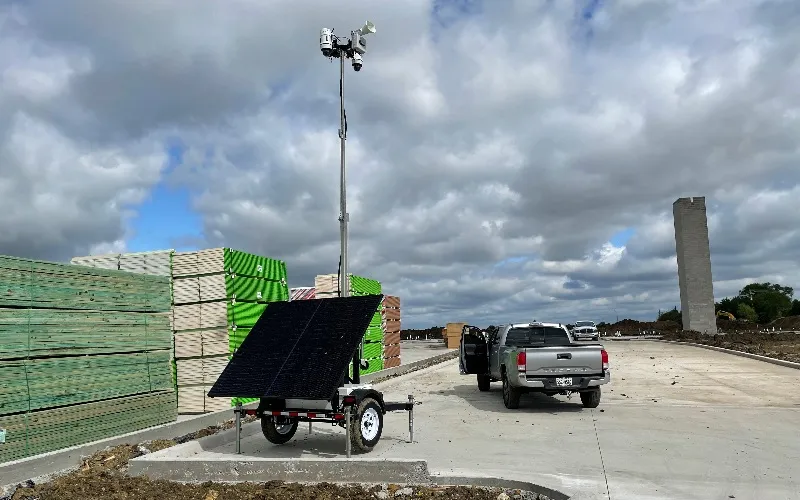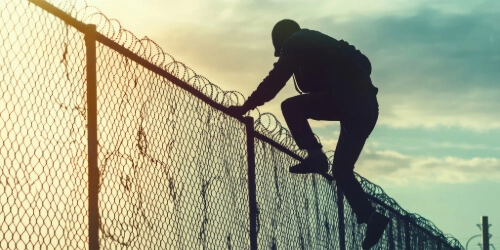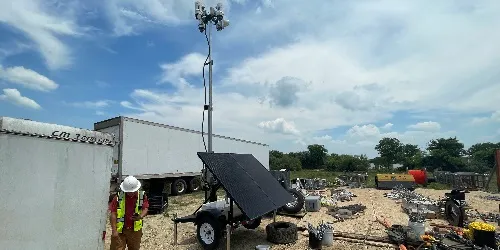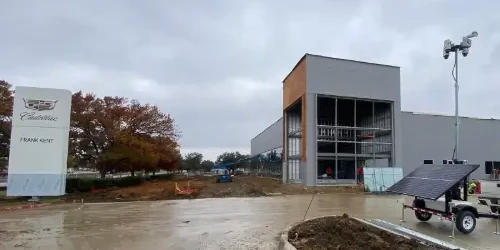IT managers in construction are no strangers to high-pressure situations.
One minute you’re troubleshooting a remote jobsite camera, the next you’re justifying budget requests to executives. Meanwhile, cyber threats keep growing, compliance rules keep shifting, and every year you’re asked to deliver “more with less.”
The US construction industry is expanding, with jobsites spread farther and tech adoption accelerating. But IT infrastructure often lags behind. Legacy systems, vendor overload, and disconnected tools leave gaps that put projects and organizations at risk.
This article unpacks the 7 biggest IT challenges facing US construction firms and shows how integrated solutions can give you control and measurable ROI.
The 7 Biggest IT Challenges Facing US Construction
From budget shortfalls to security risks, managing construction jobsite security comes with hurdles that can slow progress. Here are the biggest challenges facing the industry’s tech teams right now.
1. Budget Pressure
Construction executives are quick to approve new cranes or safety gear, but IT often gets overlooked as a non-revenue expense. IT managers are expected to deploy smart surveillance, environmental monitoring, and cloud platforms, yet the money doesn't match those demands. Instead, they’re stuck patching together point solutions that don’t scale.
Real-world impact
The result is reactive purchasing, where a single data breach or site incident forces last-minute spending at inflated costs. Tools overlap, but gaps remain. Worst of all, when executives demand proof of ROI, it’s hard to show the business value of scattered systems.
Solution
The answer lies in an all-in-one smart platform that consolidates costs while delivering measurable business value. Instead of juggling six invoices from six vendors, one integrated system cuts duplication and streamlines management. With executive-ready dashboards and reports, IT leaders can instantly demonstrate cost savings, reduced risk, and compliance improvements, finally proving IT’s strategic value at the boardroom table.
2. Cyber Threat Risks
Jobsites spread across the country introduce unpredictable entry points, and IoT devices often connect without strong oversight. Cloud platforms hold sensitive data, yet outdated firewalls and unsecured cameras leave gaps. IT teams must constantly anticipate threats like phishing attempts, ransomware, or insiders misusing access, all while staying on top of day-to-day operations.
Real-world impact
A single breach can halt projects, leak sensitive client data, or trigger expensive fines under state and federal laws. The fallout lands squarely on IT, leaving managers firefighting instead of innovating. Verizon’s 2024 DBIR notes that ransomware appears as the top threat in 92% of industries, including construction.
Solution
Unified platforms with end-to-end encryption and NDAA-compliant hardware create a secure perimeter across every jobsite. By consolidating monitoring, fewer blind spots exist for attackers to exploit. AI-driven detection also reduces false alarms, allowing IT teams to focus on genuine threats while maintaining the compliance confidence executives demand.
3. Talent Shortage
High demand and limited supply mean IT managers struggle to fill crucial roles, and retaining the experts they do hire can be even harder. Knowledge gaps emerge when teams rely too heavily on outside consultants, leaving internal staff stretched thin. This constant scramble keeps managers in reactive mode, making it difficult to focus on strategic initiatives.
Real-world impact
When the team is thin, critical projects slow down and oversight suffers. Compliance deadlines loom larger, and minor system issues can escalate into serious outages. IT leaders covering extra duties themselves risk burnout, leading to even more turnover.
Solution
Automated monitoring and AI-driven alerts help level the playing field. With systems that flag anomalies, send real-time alerts, and run diagnostics remotely, IT teams no longer need manual, constant manual oversight. Instead, scarce staff can focus on strategic initiatives, while automation closes the talent gap, keeping operations secure without endless overtime.
4. Legacy System Nightmares
Devices and software on jobsites often don’t speak the same language, forcing IT managers to bridge the gaps manually. Just applying an update or installing a patch can be risky, leading to more downtime or extra work. Siloed data means the office doesn’t receive updates from the field fast enough to nip problems in the bud.
Real-world impact
Delays ripple across the jobsite. Teams spend hours reconciling spreadsheets instead of focusing on safety or efficiency. Security gaps multiply when legacy hardware lacks modern encryption or access controls. The longer these systems persist, the greater the risk of compliance violations or missed incidents, leaving IT leaders stressed and executives frustrated.
Solution
Cloud-based integration platforms can bring old and new systems together. One centralized dashboard provides a single view of field data, security alerts, and compliance metrics. Instead of bouncing between platforms and vendors, leaders have a clearer view and can manage operations more effectively.
5. Compliance Pressures
If there’s one thing construction firms know, it’s regulation. HIPAA, state privacy laws, environmental standards, ESG reporting - the list is never-ending. Missing one update can lead to fines or audit headaches. IT teams must track, log, and report everything while still supporting operations across distributed jobsites.
Real-world impact
Slip once and the penalties bite. A missed emissions report or mishandled data record can trigger 6-figure fines, not to mention bad press that lingers long after the cheque clears. Worse still, the responsibility usually falls squarely on the IT department, even when the root cause lies elsewhere. The constant stress of “What if we missed something?” keeps IT managers reactive and drained.
Solution
Automated compliance tools change all that. With built-in monitoring of air quality, noise, smoke, and PPE, plus timestamped logs ready for export, IT leaders move from defensive scrambling to confident oversight. Instead of dreading the next audit, managers can quickly prove that the business is following the rules.
6. Vendor Sprawl and Tool Overload
Each department has its preferred tool for surveillance, environmental monitoring, safety, and communication. Soon, IT leaders are drowning in platforms, passwords, updates, and vendor calls. Disjointed systems don’t talk to each other, creating blind spots and duplicated effort.
Real-world impact
Inefficiency costs time and money. IT teams spend longer maintaining connections rather than preventing problems. Security gaps emerge because alerts are scattered across multiple tools. Executives see a confusing mess instead of a clear risk profile, making it harder to justify investments.
Solution
Consolidation is the key here. A single platform that integrates surveillance, compliance, and monitoring reduces complexity and cost. Teams can act faster, spot gaps instantly, and report value clearly. Fewer moving parts lead to reduced errors and stronger security, which poses less stress for IT managers who want control rather than chaos.
7. Remote Monitoring Issues
Traditional monitoring can’t keep pace with dispersed jobsites. Cameras, sensors, and alarms often rely on unreliable connections, and troubleshooting remotely is a nightmare. Managers spend hours traveling between sites - or they miss alerts entirely.
Real-world impact
Unchecked equipment and unnoticed safety problems slow projects down or turn emergency situations into chronic disasters. Delays grow as IT tries to figure out where things went wrong. Teams become reactive, and issues that might have been prevented get out of hand.
Solution
Cloud-based remote monitoring platforms allow IT managers to oversee multiple sites through a single interface. Mobile alerts, real-time diagnostics, and remote troubleshooting keep jobsites secure and operations flowing smoothly. IT shifts from constant reaction to proactive oversight, freeing up time for strategic initiatives.
6 Ways Integrated Solutions Transform Construction IT
Most of these challenges have the same root cause of fragmented tools and reactive firefighting. Integrated solutions give IT leaders the oversight they’ve been missing.
1. Consolidated Oversight
Instead of handling multiple vendors, managers gain one platform for surveillance trailers, pole cameras, compliance tracking, and communication.
2. Stronger Cybersecurity
Unified platforms close the gaps between devices. Every endpoint is protected with encryption and NDAA-compliant hardware.
3. Automated Compliance
Environmental monitoring systems automatically track air quality, noise, and PPE, with reports exportable for audits.
4. Remote Accessibility
Dashboards provide real-time visibility across distributed jobsites, allowing IT managers to monitor from anywhere.
5. Proven ROI
With reporting tools, IT leaders can quantify cost savings, downtime avoided, and reduced risk. For example, avoiding a single compliance fine or cyberattack can save hundreds of thousands, numbers executives can’t ignore.
6. Future-Proofing
Integrated platforms scale as firms continue their digital transformation. With Stellifii, IT managers avoid legacy lock-in and prepare their infrastructure for the next wave of smart construction tech.
See how Stellifii puts these principles into action.

Why Stellifii Gives Construction IT Leaders Control and Clarity
Stellifii is WCCTV’s cloud-based platform built specifically for construction jobsite security. It connects our mobile surveillance units, AI analytics, and environmental sensors into a single, easy-to-manage system. Instead of juggling multiple suppliers or tools, IT leaders get one hub for live video, real-time alerts, diagnostics, and compliance reporting.
The table below shows how Stellifii brings every element of site security and monitoring together.
|
IT Challenge |
How Stellifii Solves It |
|
Budget pressure |
Consolidates vendor costs and delivers executive-ready ROI dashboards. |
|
Cybersecurity risks |
Provides AES256 encryption and NDAA-compliant hardware for all devices. |
|
Talent shortage |
Automates monitoring with AI-driven alerts, reducing the need for manual oversight. |
|
Legacy systems |
Upgrading your security setup is simple with Stellifii. The platform is built to work hand-in-hand with WCCTV’s mobile surveillance units, making it easy to modernize without disrupting existing infrastructure. |
|
Compliance burdens |
Automated safety and environmental reporting reduces audit risk. |
|
Vendor sprawl |
Replaces multiple tools with one centralized platform. |
|
Remote monitoring |
Mobile access, real-time alerts, and remote diagnostics keep jobsites visible. |
By uniting WCCTV’s surveillance trailers, pole cameras, and add-on detection tools with a single cloud platform, Stellifii turns site security and compliance into one streamlined system. IT leaders get the visibility they need, executives gain the confidence of proven ROI, and construction teams benefit from smart detection systems built specifically for the demands of dynamic jobsites.
Take Control of Construction IT Challenges
Every IT leader in construction feels the weight of budget constraints, cyberthreats, compliance rules, and distributed jobsites. But you don’t have to fight every battle separately.
Stellifii consolidates the tools you need into one platform, helping you cut risks, lower expenses, and clearly show the value IT brings to your business.
Contact WCCTV to turn today’s firefighting into tomorrow’s proactive oversight.
What are the biggest challenges in the construction industry today?
The construction industry faces budget pressure, cyber threats, labor shortages, and supply chain delays. Construction companies also deal with outdated systems, fragmented tools, and compliance risks that slow down construction projects.
How can construction companies use digital tools to improve project management?
Digital tools and management software streamline project management by connecting field and office teams. Collaboration tools help reduce delays, improve oversight, and give construction companies real-time insights to manage construction projects more effectively.
Why is adopting new technologies such a challenge for the construction sector?
The construction sector often relies on legacy systems that don’t integrate with building information modeling (BIM). Many construction companies hesitate to adopt new technology due to cost, talent gaps, and system complexity.




